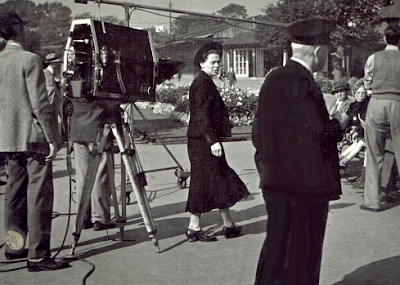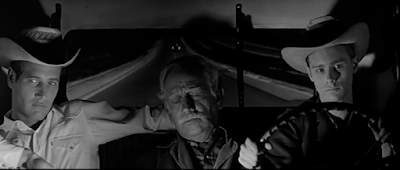The hottest day of the year and we were all indoors staying
cool with the nitrate as The Man Who Would Be Compo made like a cockney
Cagney* in London’s criminal underworld. Downtown forties London, I swear the
lights are much brighter there with sharp pin pricks of brilliance illuminating
Sheila Sim’s earrings and the West End streetlights as various cops following
sundry robbers and Richard Attenborough’s taxi was ahead of them all as he sped
on to avenge the death of his friend.
Dancing With Crime (1947), 35mm Nitrate
Jo Botting, the BFI’s Curator of Fiction, BFI National
Archive introduced this most vibrant of Brit noirs and quoted a press report
which had a confused customer apparently asking the actor for a lift, clearly
unaware of the film crew. It’s a nice touch which illustrates the film’s items
at realism on a budget an authenticity it manages to convey through the
excellence of the cinematography and the verve of the key performers. Directed
by John Paddy Carstairs, scripted by Brock Williams from an original story by Peter
Fraser, it’s a fast-paced tribute to the kind of drama Hollywood excelled in
even on a budget.
 |
| The Brit Pack: R. Attenborough, Sheila Sim and Mr Bill Owen |
If American post-war noir was dominated by mistrust and
paranoia for the Brits in this film at least, it’s about choices and how to
make a living in Civvy Street after serving their country and perhaps not
getting the recognition they deserved. For the dutiful Ted (Richard
Attenborough) it’s the long way as a cabbie, taking his time to establish
himself and his sweetheart Joy (real-life wife Sheila Sim, who lived with Dickie
in a house very much like the one she so loved in A Canterbury Tale).
His best pal Dave has different ideas though and has a lust for life and an
urgency to grab success by the throat. Dave is played by William John Owen
Rowbotham, later to re-title as Bill Owen, not just an actor but a successful songwriter,
with a later stint at Sadlers Wells Opera showing his versatility – no wonder
he carries the bounce of the Yankee Doodle Cagney.
Woman: Excuse me, are you dancing?
Detective Sgt: No, it’s just the way I walk…
Sadly, Dave’s doings land him in gangland trouble and he is
shot leading Ted on a mission to avenge his fallen comrade with the aid of Joy
who takes a job at the south London dancehall where the criminals are based. It’s
got style as well as humour with some fab adlibs from Garry Marsh as Detective
Sergeant Murray in particular. Barry Jones is all clipped malevolence as gang
leader Mr. Gregory whilst there’s also an uncredited appearance from Diana Dors
as one of the dancehalls hostesses.
It was a surprise and such an enjoyable thrilling ride which,
enhanced by the nitrate sparkle, kicked off the weekend for me in some style.
Marion Grierson with movie camera
The Grierson Sisters: Today We Live 35mm
There was actuality to follow with four documentary films (on
35mm) from the Grierson sisters Pat and Marion which illustrated the familiar
flair for producing compelling narratives about the way we live with breath-taking
seaside scenery from the south coast featured in Marion’s Beside the Seaside
(1935) including precious shots of the old Palace Pier in Brighton. Some of
this material was used in Penny Woolcock’s film From the Land to the Sea Beyond
(2011) and the cover star of Sea Power’s superb soundtrack CD duly
cartwheeled her way not once but twice in front of the camera: people enjoying
life and summer holiday freedoms, in the moment and captured for ever by the
Grierson camera.
If any newcomer to the documentary field should require a
handy compendium… relating to the craft, they will find all that they need in
Beside the Seaside. Miss Grierson has incorporated practically every apposite screen-device…
Sight and Sound, Winter 1935-6 on 35mm
Here indeed is the art of the documentary with editing,
context and narrative invention on such vibrant display. A shot at the end of
Brighton’s now skeletal pier looks to have been taken from a 1930s drone but
the reverse shot explains all as a ship sails by in close quarters. All human holiday
is here, the sun, the ice creams and the over-heated children all captured with
humour and clarity of purpose.
The same is true of Marion’s So This is London
(1933), out of the trap with what Ros Cranston, the BFI’s Curator of Non-Fiction,
identified as a poetic realism. Sister Ruby’s films, here Today We Live
(1937) and They Also Serve (1940) were gifted with the same flair but
perhaps more concerned with straightforward depictions of social reality. In the
former she shows a women’s group converting a barn into a community centre and
in the latter she showed the importance of British housewives to the war effort.
No doubt the working-class women she interviewed found her more relatable than many
a male director of the period, then again she was Scottish and no nonsense would
be the order of the day.
Paul Newman, Melvyn Douglas and Brandon de Wilde
Hud (1963), in 35mm Panavision
Christina Newland and festival curator James Bell introduced
a wide-screen Panavision spectacular in which Paul Newman plays against the
type we always want him to be as a southern man with the darkest of hearts and
a twinkle in his eye. The film’s a warning about such men and doesn’t provide
any easy way out for the viewers expecting redemption: we have to take the
lessons for ourselves and God only knows, never more so than now.
Directed by Martin Ritt, who also produced with Newman's
recently founded company, Salem Productions, it was filmed on location on the
Texas Panhandle, an aptly named flat and baren landscape which, thanks to cinematographer
James Wong Howe is used to both foreground and isolate the tempestuous
relationships on screen. Newman clearly wanted a character to stretch his
technique and he’s wonderful as the titular rancher who disappoints himself and
everyone else at turns when selfishness and inconsideration over power his decision
making. Oscars were given to Melvyn Douglas as his father Homer and to Patricia
Neal as their housekeeper Alma, loyal, good-hearted yet tough but another ultimately
let down by Hud, in spite of himself.
Homer and Hud have a far more deep-rooted beef and not just
because the latter had been driving when his brother had been killed in a car
crash leaving Homer and Hud to bring up his son Lon played by Brandon de Wilde.
The fact that de Wilde had been in Shane (1952) as the hero-worshipping
lad Joey adds an extra dimension to the post-modern “revisionist” western and Hud
is certainly no Shane… The story is about a potentially ruinous foot and mouth
outbreak on the ranch but it’s obviously about the distances between nature and
nurture, with the widest of screens giving us no peripheral escape from the
cruelty of love.
Norma Shearer and Ramon Novarro
The Student Prince of Old Heidelberg (1927), with
Carl Davis’ score, 35mm
This bittersweet treat was a heart-rending reminder of the
intoxicating fragilities of love and the inconvenient truths of duty… I had previously
seen the 2017 Pordenone screening with composer Carl Davis conducting an
orchestral performance of his score drawn from late German romanticism with
hints of the emotional turbulence of Mahler and Strauss reinforcing the drama
on screen. Davis’ daughter Hannah was there to read from her father’s diary
about his approach to composing his 7th silent film score in 1984
and his co-conspirator Kevin Brownlow was also on hand to give his finest Ernst
Lubitsch impersonation regarding his struggles to get Norma Shearer to be more
Prussian barmaid. She called in fiancée Irving Thalberg to mediate and he
played it just right by saying “Darling, I’m sure we can all learn a lot from
Mr Lubitsch…” I suppose having dealt with Herr von Stroheim on Merry-go-Round
(1923) another variation on Old Heidelberg; he appreciated a man with the
discipline to work within his budget a little more!
In fairness to Norma she does an lovely job of being in
love with Roman Novarro’s child-like Prince, sent from his duties to study
at the titular university and for all Miss Crawford’s apparent distaste for the
five-time Oscar nominee and one-time winner, she’s able to combine vulnerability
and strength, an experienced actress at 25 with her talkie glory years just
ahead. Jean Hersholt is joint MVP though as the playful, and long-suffering
Doctor Jüttner, mentoring the wayward Prince struggling to keep pace with the
fulsome ale quaffing, cigar smoking and dancing of his charge at the grand old
age if 43?! Roman Navarro has energy of his own of course and whilst he doesn’t
have the flexibility and nuance of these others he is a more than capable
leading man here, sulky and watchable!
This was also an opportunity to admire the comedy stylings
of Aberdeen’s most famous son, George K Arthur who will also be appearing in
Herr von Sternberg’s The Fortune Hunters in Bologna next week. Yes, it’s George
K Arthur Month on IThankYou Arthur and I just don’t care!
Back to the film can in hand, this is a film to luxuriate in
as is the score and the combination with a packed out NFT1 was quite something,
my head partly back in 2017 and the 1902 of 1927… with the promise of 2025
successfully ignored for two blissful hours.
And there’s more tomorrow! This is analogue beauty with a
tangibility of experience most cinemagoers are mostly denied so, let’s keep it
physical so far as possible shall we? I have seen the future of film and it’s
got sprocket holes and is really quite difficult to manage… the BFI do us
proud!
*Courtesy of Mr Mark Fuller!







+colour.png)








No comments:
Post a Comment